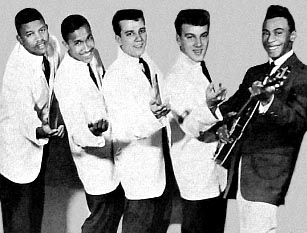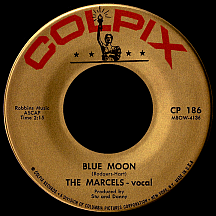THE MARCELS
Blue Moon
Showing respect for the music of their parents' generation, the doo wop singers of the '50s often recorded updated versions of popular songs from previous decades. Sometimes those valiant attempts resulted in top-selling hits, as in the case of the Harry Warren-Al Dubin classic from 1934, "I Only Have Eyes For You," atmospherically remade in '59 by Chicago's fabulous Flamingos, or the movie tune we all know, "Over the Rainbow," the 1939 Harold Arlen-E.Y. Harburg Oscar winner from The Wizard of Oz taken far, far away from Judy Garland's Kansas barnyard by Bronx group The Demensions some 21 years later. Ballads like these are one thing; uptempo adaptations are less common. The most excessively spectacular example of a fast-and-furious remake of a beloved song came with a sense of danger: The Marcels' recording of "Blue Moon" was so wild it posed a threat to the sanity of songwriter Richard Rodgers!
Constructing the song that became "Blue Moon" was a challenge for Rodgers (who wrote the melody in 1933) and Lorenz Hart (who toiled over a few lyrical rewrites). The song debuted publicly as "The Bad in Every Man," sung by Shirley Ross in the 1934 film Manhattan Melodrama starring Clark Gable. It wasn't particularly well received, so Hart came up with a more romantic set of lyrics set to the same melody. The reworked result, "Blue Moon," was a number one hit on Decca for Glen Gray and the Casa Loma Orchestra in '35. Benny Goodman and Mozambique-born singer Al Bowlly also had hits with the song that year. Billy Eckstine and Mel Torme each did likewise in 1949. Elvis Presley's recording for Sun in '54 became a hit two years later. A calypso-style version by Cincinnati R&B group The Drivers, released on RCA Victor in '57, wasn't a hit but is worthy of mention. In 1961, the song surfaced again by a Pittsburgh-based quintet named after a hairstyle (popular in the '20s and '30s, the "marcel" consisted of rows of wavy curls...or curly waves, depending on your perspective). There were some who felt the Marcels went too far, modifying the music and tangling the lyrics into a semi-unrecognizable state. Yet it became the biggest "Blue Moon" of them all!
Formed in 1959, the group was originally a racially-mixed act. The black members were guitarist and lead singer Cornelius Harp, tenor Ronald Mundy and bass Fred Johnson; the white members were baritone Richard Knauss and tenor Gene Bricker. Local entrepreneur Jules Kruspir became their manager and after a year of approaching various record companies, a demo tape found its way to Colpix in New York where producer Stu Phillips decided to give them a shot. The Rodgers-Hart tune came almost as an afterthought at the first recording session held in February 1961. With several minutes of studio time left, the guys launched into a "Blue Moon" the likes of which few could have previously imagined, fashioning an intro by bassman Johnson similar to the opening bars of "Zoom Zoom Zoom," The Collegians' 1958 single on Winley: 'ba-ma-ma-ba-ba-ba-ba-ba-ba...ba-ba-ba-ba-ba-ba...fa-dang-a-dang-dang...fa-ding-a-dong-ding-blue moon-moon-moon-blue moon...'
Without bothering to ask permission, one of the company's promotion men gave a tape of the song to high-rated WINS deejay Murray the K, who played it on his show a dozen times or more in one evening. Demand was immediate; the record shot to number one in New York City by the beginning of March. Herb Lance and the Classics, an out-of-left-field teaming of a late-'40s R&B singer with a young doo wop quartet from Brooklyn, rushed out a rough-around-the-edges cover of "Blue Moon" (imitating the crazed intro, adding some 'clang-a-lang-lang' to the 'ba-ba-bas' and 'dang-a-dangs') and hit the national charts that first week in March, right behind the Marcels, though it ran out of steam as the Steel City group's version soared to number one within a few weeks. Any problem Richard Rodgers may have had with the shocking defilement of his once-beautiful ballad was certainly eased a bit when the first royalty check arrived (Lorenz Hart, on the other hand, had no objection, as he'd been dead since 1943). In the fall, an instrumental version by The Ventures hit the charts; all in all, "Blue Moon" was one of the most-played songs of 1961.
Stu and the group stuck with the classic-remake formula, altering the exquisite "Summertime," written in 1934 by George Gershwin and DuBose Heyward for the 1935 opera Porgy and Bess, going with a more straightforward (that is, less outrageous) doo wop rendition. Released in May '61 for a projected summer run, it had already stiffed before June 21 rolled around. Then a strange, choppy interpretation of "You Are My Sunshine" (a 1939 country song composed by Jimmie Davis and Charles Mitchell) failed completely (Ray Charles modernized the song the right way a year later). Knauss and Bricker left at about this time; Allen Johnson (Fred's brother) and tenor Walt Maddox came on board and the Marcels were an all-black group the rest of the way.

Having fallen short in their attempt to take advantage of the first hit, the Marcels fell back on the disorderly style that had made "Blue Moon" successful at the risk of becoming a parody of themselves, though that's how things ultimately played out. "Heartaches," a 1931 song by Al Hoffman and John Klenner, had been recorded by many diverse artists, the most impressive being Ted Weems and his Orchestra featuring whistler Elmo Tanner in '33, a belated sensation when reissued in 1947, pulling off a long stretch at number one. The Marcels made no apologies about the similarity between "Heartaches" and their own previous chart-topper. The evidence was right there at the get-go: 'Watch out! Here we go again...yip-yip-yip-yip-werp-a-werp-werp...' and so on. Their blatancy was rewarded; the record made a steady climb in the fall and went top ten in December. But they were coming apart at the seams; Mundy left and the group continued with different members coming and going.
A quickly-thrown-together holiday song, "Merry Twist-Mas" (not a remake!), used some of the established doo wop vocal tricks; they lip-synced it onscreen in the theatrical Chubby Checker vehicle Twist Around the Clock. Then the group gave the established gimmick another try with "My Melancholy Baby," an Ernie Burnett-George A. Norton song dating all the way back to 1912 (the first hit version was by Thomas Edison protegee Walter Van Brunt on the Edison label in 1915; more recently, Tommy Edwards had scored with his lush '59 remake). The Marcels likely went too far this time, crossing the line into super-silly novelty territory: 'Ba-ma-ma-ba-ba-ba...,' interrupted by 'Nah, not that thing again, sing Melancholy Baby!...Alright, we will!...bum-ma-mum-um-mum-um-mum-mum...di-dip-doo-doo...' (you know the drill by now). It had a brief chart run in early 1962. Suspecting they could only get so far with doo-woppin' convolutions of classic songs, Stu Phillips and the group began leaning in a more straightforward (there's that borderline-appropriate word again) R&B novelty direction popularized in recent years by The Coasters, The Olympics and others. "Twistin' Fever" faltered; "Footprints in the Sand," "Flowerpot" and "Friendly Loans," all from '62, are fun songs with a lot less tongue-twisting stuntwork, but none of them reached the charts. The Marcels had only been successful when unraveling the structural integrity of classic pop songs!
Cornelius Harp departed during '62 and Colpix dropped the group the following year. At some point tenor Billy Herndon and baritone Richard Harris joined Walt Maddox and Fred Johnson (his fast-paced bass singing so important to the act's sound); the group remained a quartet, making records for a number of small labels (888, Kyra and Chartbound in the mid-'60s, Queen Bee and Monogram in the '70s). They had one single under the name Fabulous Marcels on Jules Kruspir's St. Clair label in the 1970s. A couple of attempts were made at reviving "Blue Moon," first in 1978 done disco-style on the elephant-logoed All Ears label (oddly respelling the name Marcells). They remade it again in '83 after the original hit had been featured prominently in the popular 1981 horror film An American Werewolf in London; this single, credited to Walt Maddox and the Marcels, came out on Walt's own Super M label. Maddox continued to front a group of new Marcels, taking the act beyond the 100th anniversary of Richard Rodgers' birth.


